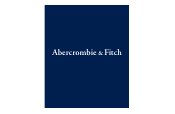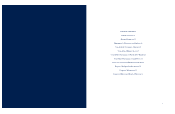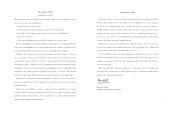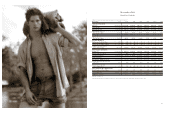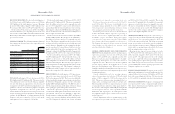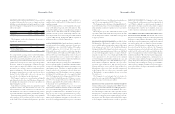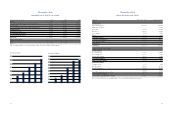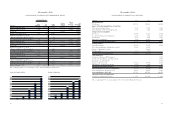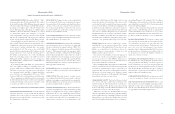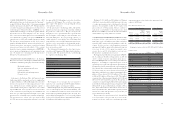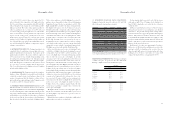Abercrombie & Fitch 2000 Annual Report Download - page 7
Download and view the complete annual report
Please find page 7 of the 2000 Abercrombie & Fitch annual report below. You can navigate through the pages in the report by either clicking on the pages listed below, or by using the keyword search tool below to find specific information within the annual report.
17
authorized stock repurchase programs. A&F is authorized to
repurchase up to an additional 2,450,000 shares under the current
repurchase program.
In 1998, financing activities consisted primarily of the repay-
ment of $50 million long-term debt to The Limited. This
occurred through the issuance of 1.2 million shares of Class A
Common Stock to The Limited with the remaining balance
paid with cash from operations. Additionally, settlement of the
intercompany balance between the Company and The Limited
occurred on May 19, 1998. During 1998, A&F also repurchased
490 thousand shares of Class A Common Stock.
CAPITAL EXPENDITURES Capital expenditures, primarily for
new and remodeled stores and the construction of a new office
and distribution center, totaled $153.5 million, $73.4 million
and $37.5 million for 2000, 1999 and 1998, respectively.
Additionally, the noncash accrual for construction in progress
totaled $9.5 million, $10.4 million and $4.4 million in 2000,
1999 and 1998, respectively. Expenditures related to the new
office and distribution center accounted for $92.3 million of
total capital expenditures in 2000, of which $12.9 million was
noncash accrual for construction in progress.
The Company anticipates spending $105 to $115 million in
2001 for capital expenditures, of which $85 to $95 million will be
for new stores, remodeling and/or expansion of existing stores and
related improvements. The balance of capital expenditures will
chiefly be related to the construction of the new home office
and distribution center. The distribution center was completed
in February 2001 and the home office was completed in April
2001. The Company intends to add approximately 825,000 gross
square feet in 2001, which will represent a 29% increase over year-
end 2000. It is anticipated the increase will result from the
addition of approximately 50 new Abercrombie & Fitch stores,
60 abercrombie stores and 20 Hollister Co. stores.
The Company estimates that the average cost for leasehold
improvements and furniture and fixtures for Abercrombie & Fitch
stores opened in 2001 will approximate $600,000 per store, after
giving effect to landlord allowances. In addition, inventory pur-
chases are expected to average approximately $300,000 per store.
The Company estimates that the average cost for leasehold
improvements and furniture and fixtures for abercrombie stores
opened in 2001 will approximate $500,000 per store, after giving
effect to landlord allowances. In addition, inventory purchases are
expected to average approximately $150,000 per store.
The Company is in the early stages of developing Hollister Co.
As a result, current average costs for leasehold improvements, fur-
niture and fixtures and inventory purchases are not representative
of future costs.
The Company expects that substantially all future capital
expenditures will be funded with cash from operations. In addi-
tion, the Company has available a $150 million credit agreement
to support operations.
RELATIONSHIP WITH THE LIMITED Effective May 19, 1998,
The Limited, Inc. (“The Limited”) completed a tax-free exchange
offer to establish A&F as an independent company. Subsequent
to the exchange offer (see Note 1 to the Consolidated Financial
Statements), A&F and The Limited entered into various service
agreements for terms ranging from one to three years. A&F hired
associates with the appropriate expertise or contracted with out-
side parties to replace those services which expired in May 1999.
Service agreements were also entered into for the continued
use by the Company of its distribution and home office space and
transportation and logistic services. The distribution space agree-
ment terminates in April 2001. The home office space service
agreement expires in May 2001. The agreement for trans-
portation and logistic services will also expire in May 2001,
although most of these services have already been transitioned
to the Company. The cost of these services generally is equal
to The Limited’s cost in providing the relevant services plus
5% of such costs.
The Company does not anticipate that costs incurred to
replace the services provided by The Limited will have a mate-
rial adverse impact on its financial condition.
RECENTLY ISSUED ACCOUNTING PRONOUNCEMENTS
Statement of Financial Accounting Standards (“SFAS”) No. 133,
“Accounting for Derivative Instruments and Hedging Activities,”
subsequently amended and clarified by SFAS No. 138, is effec-
tive for the Company’s 2001 fiscal year. It requires that derivative
instruments be recorded at fair value and that changes in their
fair value be recognized in current earnings unless specific hedg-
ing criteria are met. The adoption of this standard had no impact
on the Company’s financial position or results of operations.
Abercrombie &Fitch
16
LIQUIDITY AND CAPITAL RESOURCES Cash provided by
operating activities provides the resources to support operations,
including seasonal requirements and capital expenditures. A sum-
mary of the Company’s working capital position and capitalization
follows (thousands):
2000 1999 1998
Working capital $149,000 $162,351 $ 95,890
Capitalization:
Shareholders’ equity $422,700 $311,094 $186,105
The Company considers the following to be measures of
liquidity and capital resources:
2000 1999 1998
Current ratio (current assets divided
by current liabilities) 1.96 2.18 1.78
Cash flow to capital investment
(net cash provided by operating
activities divided by capital expenditures) 99% 208% 451%
Net cash provided by operating activities totaled $151.2 million,
$152.8 million and $169.0 million for 2000, 1999 and 1998, respec-
tively. Cash was provided primarily by current year net income
adjusted for depreciation and amortization, and increased accounts
payable and accrued expenses needed to support the growth in
inventories. Cash was used primarily to fund inventory pur-
chases required to support the addition of new stores and the
investment in new women’s categories, including underwear,
gymwear and fragrances. The inventory increase is also due to
the timing of spring deliveries as a result of the 2000 fiscal year
having 53 weeks. Additionally, cash used for income taxes
increased due to the timing of income tax payments.
The Company’s operations are seasonal in nature and typically
peak during the back-to-school and Christmas selling periods.
Accordingly, cash requirements for inventory expenditures are
highest during these periods.
Cash outflows for investing activities were primarily for capital
expenditures related to new and remodeled stores (net of con-
struction allowances) and the construction costs of the new office
and distribution center. In 2000 and 1999, investing activities
also included maturities and purchases of marketable securities.
Financing activities during 2000 and 1999 consisted primarily
of the repurchase of 3,550,000 shares and 1,510,000 shares, respec-
tively, of A&F’s Class A Common Stock pursuant to previously
Abercrombie &Fitch
IMPACT OF INFLATION The Company’s results of opera-
tions and financial condition are presented based upon historical
cost. While it is difficult to accurately measure the impact of
inflation due to the imprecise nature of the estimates required,
the Company believes that the effects of inflation, if any, on its
results of operations and financial condition have been minor.
SAFE HARBOR STATEMENT UNDER THE PRIVATE SECU-
RITIES LITIGATION REFORM ACT OF 1995 A&F cautions
that any forward-looking statements (as that term is defined in
the Private Securities Litigation Reform Act of 1995) contained
in this Report or made by management of A&F involve risks and
uncertainties and are subject to change based on various impor-
tant factors. The following factors, among others, in some cases
have affected and in the future could affect the Company’s
financial performance and actual results and could cause actual
results for 2001 and beyond to differ materially from those
expressed or implied in any of the forward-looking statements
included in this Form 10-K or otherwise made by management:
changes in consumer spending patterns, consumer preferences
and overall economic conditions, the impact of competition and
pricing, changes in weather patterns, political stability, currency
and exchange risks and changes in existing or potential duties,
tariffs or quotas, availability of suitable store locations at appro-
priate terms, ability to develop new merchandise and ability to
hire and train associates.

